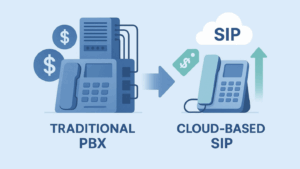
Cloud Telephony Demystified: Understanding Its Features and Benefits
Unlocking the Power of Cloud Telephony Solutions
Cloud telephony solutions are revolutionizing the way businesses communicate. They enable you to manage calls over the internet instead of traditional phone lines, offering a host of benefits that are particularly invaluable for small to medium-sized businesses. Here’s a quick snapshot of why cloud telephony might be the right choice for you:
- Ease of Installation: No need for extensive hardware; just an internet connection and a browser.
- High Mobility: Stay connected anywhere, anytime with your smartphone or laptop.
- Cost Efficiency: Reduce costs associated with maintenance and large infrastructure.
- Enhanced Oversight: Track and record calls, and integrate with CRM systems for better performance analytics.
The pandemic has shifted how businesses operate, making remote work and hybrid models more common. This change has underscored the need for flexible, scalable, and cost-effective communication solutions. Cloud telephony, a $23 billion market, meets these demands with ease, transforming business operations across various industries—from healthcare and finance to direct-to-consumer (D2C) brands and telemedicine.
In terms of evolution, cloud telephony leverages Voice over Internet Protocol (VoIP) technology to modernize how we handle voice communication. This shift enables businesses to break free from the limitations of traditional phone systems, making way for richer, more integrated communication experiences.

By embracing cloud telephony, you not only enhance operational efficiency but also elevate customer satisfaction and streamline collaboration. Dive deeper into this article to explore how cloud telephony solutions can transform your business communications.
What is Cloud Telephony?
Cloud telephony is a modern voice communication service that uses the internet to deliver calls. Unlike traditional phone systems that rely on physical hardware and landlines, cloud telephony leverages the power of the cloud to offer flexible, scalable, and cost-effective communication solutions.
Technology Behind Cloud Telephony
Cloud telephony operates on Voice over Internet Protocol (VoIP) technology. VoIP converts analog voice signals into digital data packets, which are then transmitted over the internet. This technology enables you to make and receive calls from any device connected to the internet, whether it’s a smartphone, computer, or VoIP desk phone.
Unified Communications as a Service (UCaaS) packages often include cloud telephony as a core component. UCaaS brings together various communication tools—such as voice calls, video conferencing, messaging, and file sharing—into a single, cloud-based platform. This integration eliminates the need for multiple, disjointed communication tools, enhancing workplace productivity and organization.
Key Components
To understand how cloud telephony works, let’s break down its key components:
- VoIP Technology: Converts audio signals into digital data packets and transmits them over the internet.
- Internet Connection: A stable and strong internet connection is crucial for high-quality voice calls.
- Third-Party Provider: Hosts and maintains the telephony platform, ensuring reliability and scalability.
- Endpoints: Devices like smartphones, computers, and IP desk phones that connect to the cloud telephony service.
Benefits of UCaaS
UCaaS offers a unified platform for all communication needs, streamlining business operations. Here are some of the benefits:
- Scalability: Easily add or remove users as your business grows.
- Flexibility: Employees can work from anywhere, as long as they have an internet connection.
- Cost-Effectiveness: Reduce overhead costs by eliminating the need for physical hardware and maintenance.
- Enhanced Security: Advanced encryption and compliance standards to protect sensitive information.
By adopting cloud telephony solutions, businesses can improve operational efficiency, enhance communication, and boost customer satisfaction. According to TechTarget, the VoIP market is expected to grow significantly, highlighting the increasing adoption of cloud-based communication systems.
Key Features of Cloud Telephony Solutions
Scalability
One of the most significant advantages of cloud telephony solutions is their scalability. Traditional phone systems require physical hardware, which can be costly and time-consuming to expand. With cloud telephony, you can add or remove users on-demand with just a few clicks. This makes it an ideal solution for businesses experiencing growth or seasonal fluctuations in call volume. Efficient onboarding ensures that new employees can start using the system immediately, without the need for extensive setup.
Flexibility
Cloud telephony offers unparalleled flexibility, making it perfect for modern work environments. Employees can take and make calls from anywhere with an internet connection, supporting remote work and global access. This flexibility is crucial as more companies adopt remote working models. According to a report by Microsoft, an estimated 36.2 million Americans will be working remotely by 2025. With cloud telephony, your team can stay connected whether they’re in the office, at home, or on the go.
Cost-effectiveness
Switching to cloud telephony solutions can significantly reduce overhead costs. Traditional phone systems come with high initial costs for hardware and ongoing maintenance fees. In contrast, cloud telephony operates over your existing internet connection, eliminating the need for expensive hardware. Predictable pricing models mean you only pay for the services you use, making budgeting easier. According to SIP.US, businesses can save dramatically on monthly expenses by adopting cloud-based VoIP.
Security
Security is a top concern for any business, and cloud telephony solutions offer robust measures to protect your data. Advanced encryption protocols like Secure Real-time Transport Protocol (SRTP) and Transport Layer Security (TLS) ensure that your calls are secure. Compliance with industry standards such as HIPAA, PCI, and SOC 2 is also essential. These standards ensure that your provider meets stringent security requirements, safeguarding sensitive information.
Benefits of Implementing Cloud Telephony Solutions
Implementing cloud telephony solutions can transform the way your business operates, communicates, and serves customers. Let’s explore how these solutions enhance operational efficiency, communication, and customer satisfaction.
Operational Efficiency
Cloud telephony solutions streamline operations by reducing the need for physical infrastructure and maintenance. Traditional phone systems require significant investments in hardware and ongoing maintenance. In contrast, cloud telephony operates over the internet, eliminating these costs and reducing the IT burden.
For example, a company can avoid the hassle of maintaining a PBX system and instead use cloud telephony, which requires only an internet connection and a web browser. This simplicity allows businesses to focus on their core activities rather than managing complex telephony systems.
Moreover, cloud telephony integrates seamlessly with other business tools like CRM and helpdesk software. This integration means employees can access all necessary information from a single platform, enhancing productivity and reducing time spent switching between applications.
Enhanced Communication
Unified communications are a hallmark of cloud telephony solutions. By using SIP trunks to combine voice, video, and text in a single platform, employees can communicate more effectively and collaborate seamlessly. SIP trunking is just one technology opening up a new world for businesses tied to physical phone lines.
Imagine your sales team using a unified system that integrates calling, video conferencing, and instant messaging. This setup allows them to switch between communication modes effortlessly, improving response times and ensuring no message is missed.
Real-time call transcriptions and detailed call analytics further enhance communication. These features provide insights into employee performance, customer interactions, and overall communication effectiveness. Companies can use this data to refine their communication strategies and train employees more effectively.
Customer Satisfaction
Customer satisfaction is crucial for any business, and cloud telephony solutions can significantly enhance it. These systems offer features like call routing, IVR (Interactive Voice Response), and automated calling, ensuring customers reach the right department quickly and efficiently.
For instance, a customer calling for support can be greeted by an IVR system and routed to the appropriate team based on their selection. This reduces wait times and ensures customers receive prompt assistance.
Additionally, cloud telephony’s call recording and analytics features allow businesses to monitor and improve service quality continuously. By analyzing call data, companies can identify areas for improvement and train their staff to handle customer inquiries more effectively.
By adopting cloud telephony solutions, businesses can achieve operational efficiency, enhance communication, and boost customer satisfaction. In the next section, we’ll explore how these solutions work and the technology behind them.
How Cloud Telephony Solutions Work
Cloud telephony uses the internet to make and receive calls instead of traditional phone lines. This makes communication more flexible, scalable, and cost-effective for businesses.
VoIP Technology
Voice over Internet Protocol (VoIP) technology is at the heart of cloud telephony. It converts your voice into digital signals and sends them over the internet. When you speak, your voice is turned into data packets that travel to the receiver. At the other end, these packets are converted back into sound. This allows you to make calls from a computer, a special VoIP phone, or even a regular phone with an adapter.
Internet Dependency
Cloud telephony relies on a stable internet connection. The quality of your calls depends on your internet speed and reliability. With a strong connection, you can expect clear calls and minimal delays. Many businesses use wireless “hot spots” in places like cafes, parks, and airports to stay connected and use VoIP services on the go.
SIP Trunks
Session Initiation Protocol (SIP) trunks are essential for cloud telephony. SIP trunks connect your business phone system to the internet, allowing you to make and receive calls through VoIP. They replace traditional phone lines and offer more features. SIP trunks are easy to scale, letting you add or remove lines as your business needs change. They also provide cost savings by reducing the need for multiple phone lines and allowing for cheaper long-distance calls.
Cloud telephony, powered by VoIP technology, stable internet, and SIP trunks, offers a modern, efficient, and flexible way for businesses to communicate.
Data Packets
VoIP technology relies on data packets to transmit voice signals. Here’s a simple breakdown of how it works:
- Voice Signal Conversion: Your voice is converted into digital data packets.
- Data Transmission: These packets are sent over the internet.
- Signal Reversion: At the receiving end, the packets are converted back into audio signals.
This process happens in real-time, ensuring smooth and clear communication.
Data packets are efficient and allow for high-quality calls. They also enable other features like call recording, analytics, and integration with other business tools.
By understanding these core components, businesses can appreciate how cloud telephony solutions provide reliable, flexible, and scalable communication options.
Frequently Asked Questions about Cloud Telephony Solutions
What is the difference between cloud telephony and traditional PBX?
Cloud telephony and traditional PBX (Private Branch Exchange) systems might seem similar on the surface, but they differ significantly in functionality and infrastructure.
Traditional PBX relies on physical hardware installed at your business location. It connects internal phone extensions to the Public Switched Telephone Network (PSTN). Setup and maintenance can be costly and time-consuming. Additionally, scaling up requires more hardware and technical expertise.
Cloud telephony, on the other hand, operates over the internet using VoIP technology. It eliminates the need for extensive on-site hardware. Your service provider manages the infrastructure, making it easier to scale up or down. Employees can make and receive calls from any internet-connected device, offering unmatched flexibility.

How can cloud telephony reduce costs for businesses?
Cloud telephony offers several cost-saving benefits:
-
Lower Setup Costs: No need to invest in expensive hardware. All you need is a reliable internet connection and compatible devices like smartphones or laptops.
-
Reduced Maintenance: The service provider handles maintenance and upgrades, eliminating the need for in-house IT staff or costly service contracts.
-
Scalable Pricing: Pay only for what you use. Add or remove users easily without the need for additional hardware. This flexibility helps manage costs effectively.
-
Unified Billing: Cloud telephony often includes features like SMS, video conferencing, and CRM integration in a single package, simplifying billing and reducing the need for multiple service providers.
According to a Gallup study, nearly 8 in 10 employees report improved productivity due to remote work capabilities, which can indirectly reduce operational costs.
What are the security measures in cloud telephony?
Security is a significant concern for businesses moving to cloud telephony. Here are some key measures that ensure your data remains secure:
-
Encryption: Secure Real-time Transport Protocol (SRTP) and Transport Layer Security (TLS) encrypt voice data, making it difficult for unauthorized parties to intercept.
-
Compliance Standards: Reputable providers adhere to industry standards like HIPAA, PCI, ISO/IEC 20071, and SOC 2 compliance. These certifications ensure robust security practices.
-
Redundancy and Failover: Cloud telephony solutions typically offer high uptime by using multiple data centers. This redundancy ensures that even if one center goes down, your service remains uninterrupted.
-
Regular Audits: Providers often conduct regular security audits and updates to stay ahead of potential threats.
-
Access Controls: Advanced access controls ensure that only authorized personnel can access sensitive information.
Choosing the Right Cloud Telephony Provider
Selecting the right cloud telephony provider is crucial for your business. Here are the key factors to consider:
Service Quality
Uptime and Reliability: Your provider must guarantee high uptime. Look for at least a 99.99% uptime guarantee. This ensures your phone service is always available. Providers should also offer redundant data centers to prevent service interruptions.
Network Monitoring: Ensure your provider offers 24/7 network monitoring. This proactive approach helps identify and resolve issues before they impact your business.
Features
IVR and Call Routing: Interactive Voice Response (IVR) systems and advanced call routing are must-haves. IVR can handle customer queries automatically, while call routing ensures calls reach the right person quickly.
Analytics: Good providers offer detailed analytics. Metrics like call duration, number of calls, and response times help you understand and improve your communication processes. These insights can lead to better employee performance and customer satisfaction.
Integration Capabilities: Your cloud telephony should seamlessly integrate with your existing tools like CRM and project management software. This makes it easier for your team to adopt the new system without disrupting workflows.
Customer Support
24/7 Availability: Customer support should be available round the clock. Whether it’s a minor issue or a major outage, you need to know that help is just a call or click away.
Technical Expertise: The support team should not only be available but also knowledgeable. They should be able to resolve issues quickly and efficiently. Testing a provider’s support by requesting a demo can give you a good idea of their service quality.
Conclusion
The future of communication is rapidly evolving, and cloud telephony solutions are at the forefront of this transformation. As businesses strive for greater flexibility, scalability, and cost-efficiency, cloud telephony offers a robust answer to these demands. The shift from traditional PBX systems to cloud-based communication platforms is not just a trend—it’s a significant leap towards smarter, more integrated business operations.
The industry impact of cloud telephony is profound. Companies adopting these solutions are experiencing streamlined operations, reduced IT burdens, and improved customer interactions. The integration of advanced technologies like AI and machine learning will further enhance these systems, making them even more indispensable for businesses of all sizes.
Get started with SIP.US and transition to a future-ready communication system.



